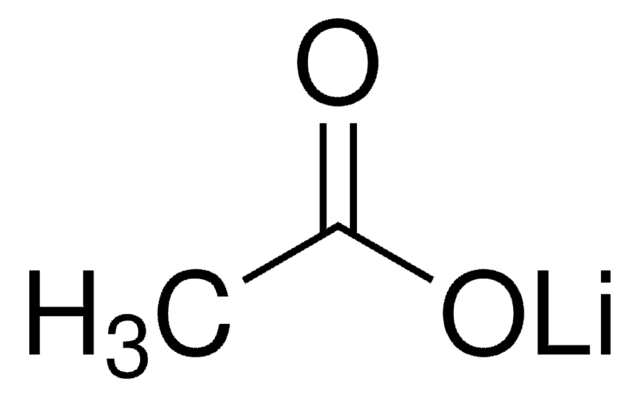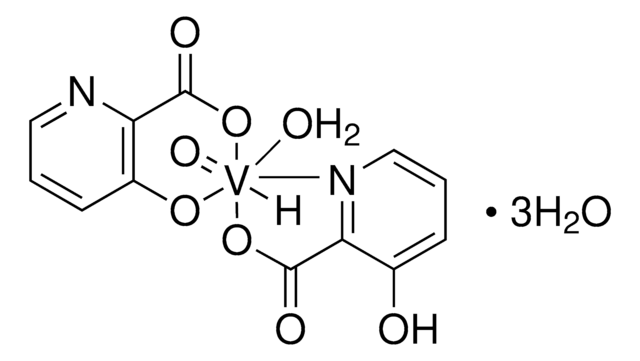62476
Lithium chloride
BioUltra, for molecular biology, anhydrous, ≥99.0% (AT)
Sinonimo/i:
LiCl
About This Item
Prodotti consigliati
Grado
Molecular Biology
for molecular biology
Nome Commerciale
BioUltra
Saggio
≥99.0% (AT)
Stato
powder or crystals
Impurezze
DNases, none detected
RNases, none detected
insoluble matter, passes filter test
phosphatases, none detected
proteases, none detected
≤0.001% total nitrogen (N)
Perdita
≤1% loss on drying, 110 °C
pH
5.0-7.5 (25 °C, 1 M in H2O)
Punto di fusione
605 °C (lit.)
Solubilità
H2O: 1 M at 20 °C, clear, colorless
Anioni in tracce
sulfate (SO42-): ≤50 mg/kg
Cationi in tracce
Al: ≤5 mg/kg
As: ≤0.2 mg/kg
Ba: ≤10 mg/kg
Bi: ≤5 mg/kg
Ca: ≤10 mg/kg
Cd: ≤5 mg/kg
Co: ≤5 mg/kg
Cr: ≤5 mg/kg
Cu: ≤5 mg/kg
Fe: ≤5 mg/kg
K: ≤50 mg/kg
Mg: ≤5 mg/kg
Mn: ≤5 mg/kg
Mo: ≤5 mg/kg
Na: ≤50 mg/kg
Ni: ≤10 mg/kg
Pb: ≤5 mg/kg
Sr: ≤5 mg/kg
Zn: ≤5 mg/kg
λ
1 M in H2O
Assorbanza UV
λ: 260 nm Amax: 0.01
λ: 280 nm Amax: 0.01
Stringa SMILE
[Li+].[Cl-]
InChI
1S/ClH.Li/h1H;/q;+1/p-1
KWGKDLIKAYFUFQ-UHFFFAOYSA-M
Cerchi prodotti simili? Visita Guida al confronto tra prodotti
Categorie correlate
Applicazioni
- The preconditioning of lithium promotes mesenchymal stem cell-based therapy for the degenerated intervertebral disc via upregulating cellular ROS: This study explores the use of lithium chloride in enhancing the efficacy of mesenchymal stem cells for intervertebral disc regeneration. Lithium chloride′s role in modulating cellular responses and oxidative stress mechanisms presents a potential application in developing advanced IVD (In Vitro Diagnostics) products that rely on cellular technologies (Zhu et al., 2021).
Altre note
Avvertenze
Warning
Indicazioni di pericolo
Consigli di prudenza
Classi di pericolo
Acute Tox. 4 Oral - Eye Irrit. 2 - Skin Irrit. 2
Codice della classe di stoccaggio
13 - Non Combustible Solids
Classe di pericolosità dell'acqua (WGK)
WGK 1
Punto d’infiammabilità (°F)
Not applicable
Punto d’infiammabilità (°C)
Not applicable
Dispositivi di protezione individuale
dust mask type N95 (US), Eyeshields, Gloves
Scegli una delle versioni più recenti:
Possiedi già questo prodotto?
I documenti relativi ai prodotti acquistati recentemente sono disponibili nell’Archivio dei documenti.
I clienti hanno visto anche
Il team dei nostri ricercatori vanta grande esperienza in tutte le aree della ricerca quali Life Science, scienza dei materiali, sintesi chimica, cromatografia, discipline analitiche, ecc..
Contatta l'Assistenza Tecnica.





